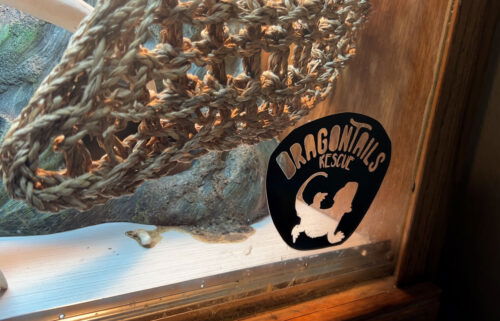Protect your pets this winter
IDAHO FALLS, Idaho (KIFI) – As the winter months continue, we need to remember we aren't the only ones that can feel the harsh cold.
Pets can have trouble staying healthy and happy as they are sometimes limited in their activity, as it is often too cold for most indoor pets to be outside for extended periods of time.
TrustedHousesitters has shared advice to Idaho residents on how to ensure the safety and well-being of their pets in the upcoming cold and rainy weather.
“Most of us take sensible actions over the winter to look after ourselves, but we also need to think about how to keep our pets safe,” veterinary surgeon Rebecca MacMillan said. “The chilly weather can be enjoyed safely with our furry companions as long as you take a few simple precautions.”
In addition to bundling up and staying indoors when possible, veterinarians urge Idaho residents to practice the following ten winter pet safety tips:
1. Protect The Paws – Salt and ice-melting chemicals can be harmful to your pet's paws. Make sure to clean their paws after walks and consider using pet-safe ice melts on your property. Pet booties can also provide protection and warmth during winter walks.
“If you have a dog with thin fur, low body fat, or they are very old or young, then a coat is a must,” MacMillan said. “Boots are a good idea for dog’s paws if you live in an area where snow is likely. These will keep your pet’s feet warm, as well as safe from any debris that might be hidden underneath the snow.”
2. Monitor Food Intake – Some pets may require additional calories during the cold weather to generate energy and stay warm, while some need a decrease in calories. MacMillan encourages pet owners to talk to their veterinarians about food intake during winter.
“Many of us spend more time indoors in the winter months, which means our pets do too,” MacMillan said. “Being less active means pets' energy requirements may reduce over the winter months. Monitor your pet’s weight carefully and go easy on treats and titbits to avoid an expanding waistline. Conversely, animals that live or work outdoors may actually need more calories in the winter, so monitor their body condition closely.”
3. Keep a Full Water Bowl – It’s a common misconception that pets are only at risk for dehydration in warm temperatures. However, cold weather can contribute to dehydration in pets, so make sure they always have access to fresh water.
4. Be Cautious with Space Heaters – Keep pets away from space heaters and other heat sources, as they can cause burns or start fires if knocked over.
“Pick one with an anti-tip feature to prevent it from being knocked over and a cool-touch exterior to prevent burning,” MacMillan said. “Put it in a low-traffic area to further limit the risks of injury.”
5. Stay Up to Date on Vaccines – Make sure your pet's vaccinations are current, as cold weather can increase their risk of contracting certain illnesses.
6. Don’t Leave Pets in the Car – While many pet owners understand the dangers of leaving pets in hot cars, cold cars can be just as dangerous for pets. The interior of a car holds in cold like a refrigerator, which can cause animals to freeze.
7. Keep Baths to a Minimum – Like humans, it’s common for pets to get dry, itchy and flaky skin in the winter. The ASPCA recommends pet owners keep bathing to a minimum and keep their homes humidified to avoid dry skin on pets during the winter. However, be sure to wash your dog’s paws after a walk in the winter.
“This will wash off any grit that may have been spread on roads and paths as a deicer,” McMillan said. “Grit and rock salt can be irritating to sensitive paws, and your dog may also ingest it as he grooms himself. Antifreeze is also a danger at this time of year, so if you think it has accidentally stepped in a spillage outside, then washing your dog’s paws will help.”
8. Check Your Engine – Outdoor and feral cats often use warm engines as a heat source in cold temperatures. Before using your vehicle, ensure outdoor animals’ safety by checking underneath your car and honking to alert any furry visitors.
9. Watch For Signs of Hypothermia and Frostbite – If your pet exhibits symptoms such as shivering, lethargy, ice on their body, or discolored skin, contact your veterinarian immediately. Check your pet's ears, tail, and paws for signs of frostbite, which can appear as pale or gray skin that's cold to the touch.
10. Prepare for power outages and storms – In case of power outages and closures from potential winter storms, it is prudent to ensure you have enough supplies to keep you going for a few days.
“This includes any regular medication that your pet is on, as well as their food,” MacMillan said. “The holidays may also mean there are some days when your vet or local pet store is closed, so plan ahead and again make sure your pet doesn’t go without.
Angela Laws, TrustedHousesitters Head of Community, said, "In light of the expected colder and rainier winter season, it is crucial for pet owners and pet sitters alike to be well-equipped with the knowledge and skills to provide proper care for our beloved pets. Ensuring their safety, comfort, and well-being during these harsh weather conditions is not only a responsibility but a testament to our love for these cherished family members."
She adds, "Together, let's create a warm and safe environment for our pets to enjoy, even during the coldest of winters."






